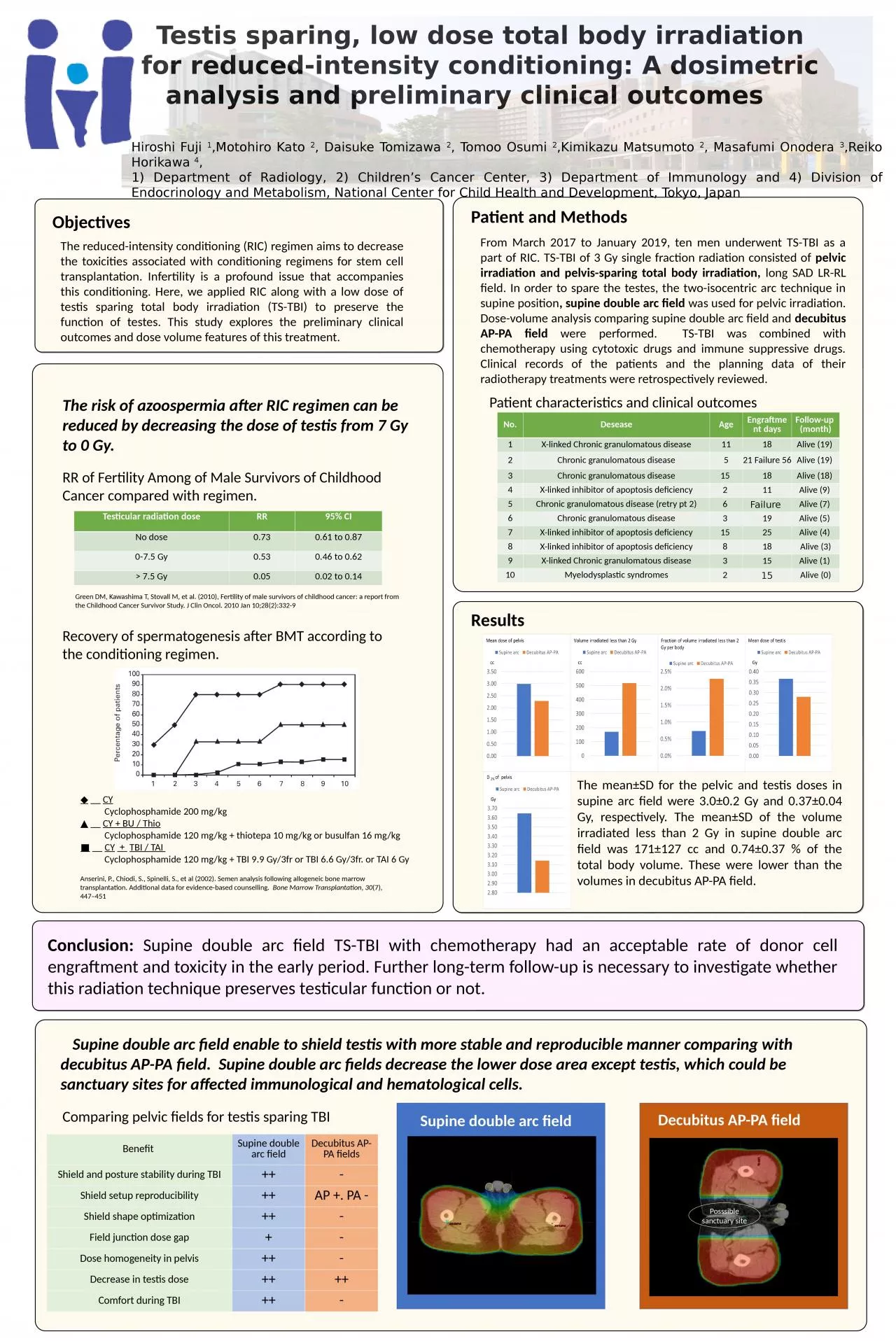

CY BU Thio Cyclophosphamide 120 mgkg thiotepa 10 mgkg or busulfan 16 mgkg CY TBI TAI Cyclophosphamide 120 mgkg TBI 99 Gy 3fr or TBI 66 Gy 3fr or TAI 6 ID: 920364
Download Presentation The PPT/PDF document "◆ CY Cyclophosphamide 2..." is the property of its rightful owner. Permission is granted to download and print the materials on this web site for personal, non-commercial use only, and to display it on your personal computer provided you do not modify the materials and that you retain all copyright notices contained in the materials. By downloading content from our website, you accept the terms of this agreement.
Slide1
◆
CY
Cyclophosphamide 200 mg/kg
▲
CY + BU / Thio Cyclophosphamide 120 mg/kg + thiotepa 10 mg/kg or busulfan 16 mg/kg■ CY+TBI / TAI Cyclophosphamide 120 mg/kg + TBI 9.9 Gy/3fr or TBI 6.6 Gy/3fr. or TAI 6 Gy
Anserini
, P., Chiodi, S., Spinelli, S., et al (2002). Semen analysis following allogeneic bone marrow transplantation. Additional data for evidence-based counselling. Bone Marrow Transplantation, 30(7), 447–451
Green DM, Kawashima T, Stovall M, et al. (2010), Fertility of male survivors of childhood cancer: a report from the Childhood Cancer Survivor Study. J Clin Oncol. 2010 Jan 10;28(2):332-9
RR of Fertility Among of Male Survivors of Childhood Cancer compared with regimen.
The risk of azoospermia after RIC regimen can be reduced by decreasing the dose of testis from 7 Gy to 0 Gy.
Testicular radiation doseRR95% CINo dose0.730.61 to 0.870-7.5 Gy0.530.46 to 0.62> 7.5 Gy0.050.02 to 0.14
No.DeseaseAgeEngraftment daysFollow-up (month)1X-linked Chronic granulomatous disease1118Alive (19) 2Chronic granulomatous disease521 Failure 56Alive (19) 3Chronic granulomatous disease15 18Alive (18) 4X-linked inhibitor of apoptosis deficiency2 11Alive (9) 5Chronic granulomatous disease (retry pt 2)6 Failure Alive (7) 6Chronic granulomatous disease3 19Alive (5) 7X-linked inhibitor of apoptosis deficiency15 25Alive (4) 8X-linked inhibitor of apoptosis deficiency8 18Alive (3)9X-linked Chronic granulomatous disease3 15Alive (1) 10Myelodysplastic syndromes2 15Alive (0)
Testis sparing, low dose total body irradiation for reduced-intensity conditioning: A dosimetric analysis and preliminary clinical outcomes
The reduced-intensity conditioning (RIC) regimen aims to decrease the toxicities associated with conditioning regimens for stem cell transplantation. Infertility is a profound issue that accompanies this conditioning. Here, we applied RIC along with a low dose of testis sparing total body irradiation (TS-TBI) to preserve the function of testes. This study explores the preliminary clinical outcomes and dose volume features of this treatment.
Benefit Supine double arc fieldDecubitus AP-PA fieldsShield and posture stability during TBI++-Shield setup reproducibility++AP +. PA -Shield shape optimization++-Field junction dose gap+-Dose homogeneity in pelvis++-Decrease in testis dose++++Comfort during TBI++-
Supine double arc field enable to shield testis with more stable and reproducible manner comparing with decubitus AP-PA field. Supine double arc fields decrease the lower dose area except testis, which could be sanctuary sites for affected immunological and hematological cells.
Comparing pelvic fields for testis sparing TBI
Recovery of spermatogenesis after BMT according to the conditioning regimen.
Patient characteristics and clinical outcomes
From March 2017 to January 2019, ten men underwent TS-TBI as a part of RIC. TS-TBI of 3 Gy single fraction radiation consisted of pelvic irradiation and pelvis-sparing total body irradiation, long SAD LR-RL field. In order to spare the testes, the two-isocentric arc technique in supine position, supine double arc field was used for pelvic irradiation. Dose-volume analysis comparing supine double arc field and decubitus AP-PA field were performed. TS-TBI was combined with chemotherapy using cytotoxic drugs and immune suppressive drugs. Clinical records of the patients and the planning data of their radiotherapy treatments were retrospectively reviewed.
Conclusion: Supine double arc field TS-TBI with chemotherapy had an acceptable rate of donor cell engraftment and toxicity in the early period. Further long-term follow-up is necessary to investigate whether this radiation technique preserves testicular function or not.
Objectives
The mean
±
SD for the pelvic and testis doses in supine arc field were 3.0
±0.2 Gy and 0.37±0.04 Gy, respectively. The mean±SD of the volume irradiated less than 2 Gy in supine double arc field was 171±127 cc and 0.74±0.37 % of the total body volume. These were lower than the volumes in decubitus AP-PA field.
Results
Patient and Methods
Decubitus AP-PA field
Supine double arc field
Posssible
sanctuary site
Hiroshi Fuji
1
,Motohiro Kato
2
, Daisuke
Tomizawa
2
,
Tomoo Osumi 2,Kimikazu Matsumoto 2, Masafumi Onodera 3,Reiko Horikawa 4,1) Department of Radiology, 2) Children’s Cancer Center, 3) Department of Immunology and 4) Division of Endocrinology and Metabolism, National Center for Child Health and Development, Tokyo, Japan